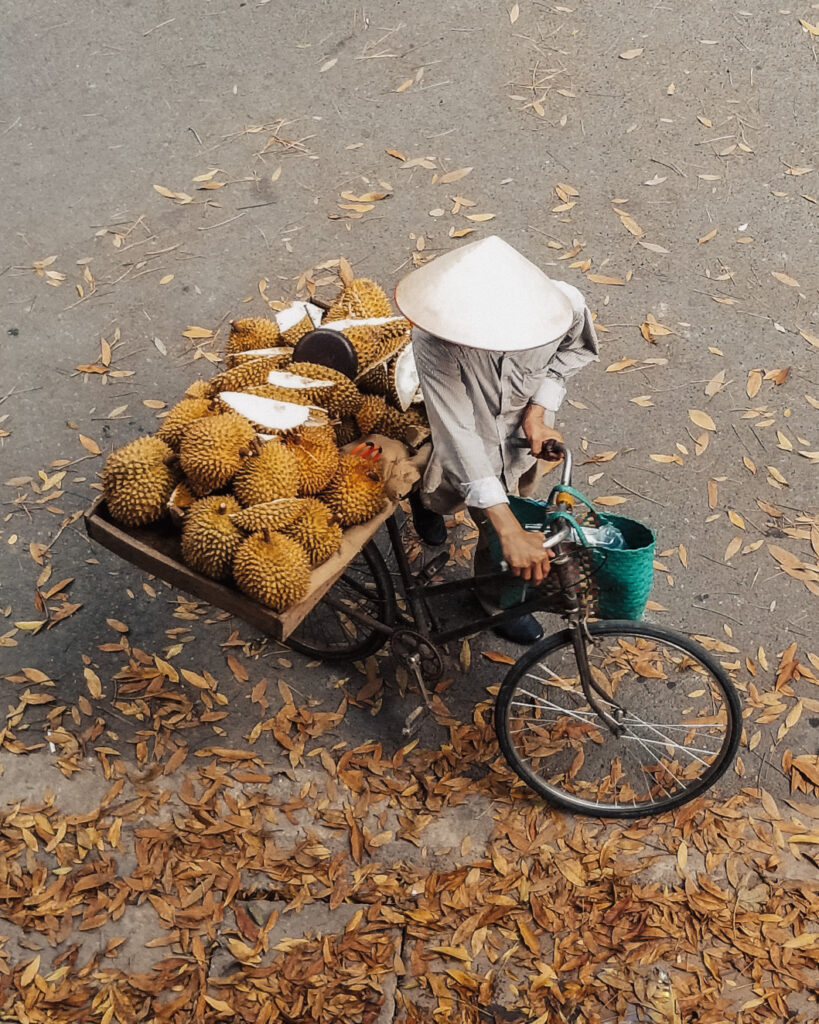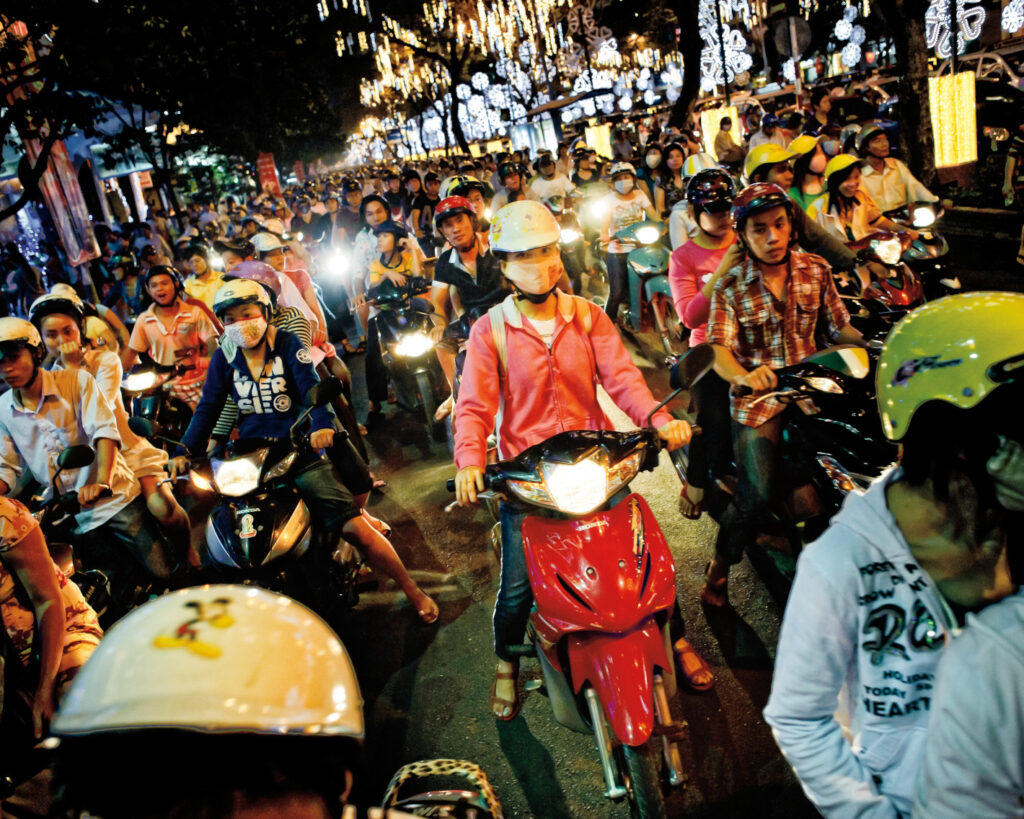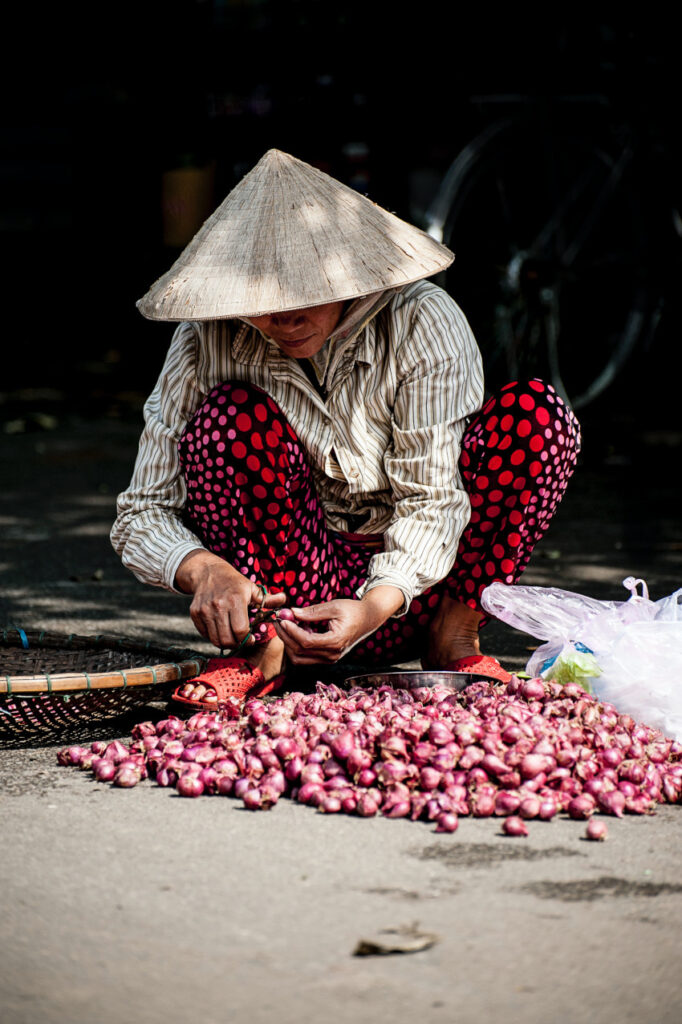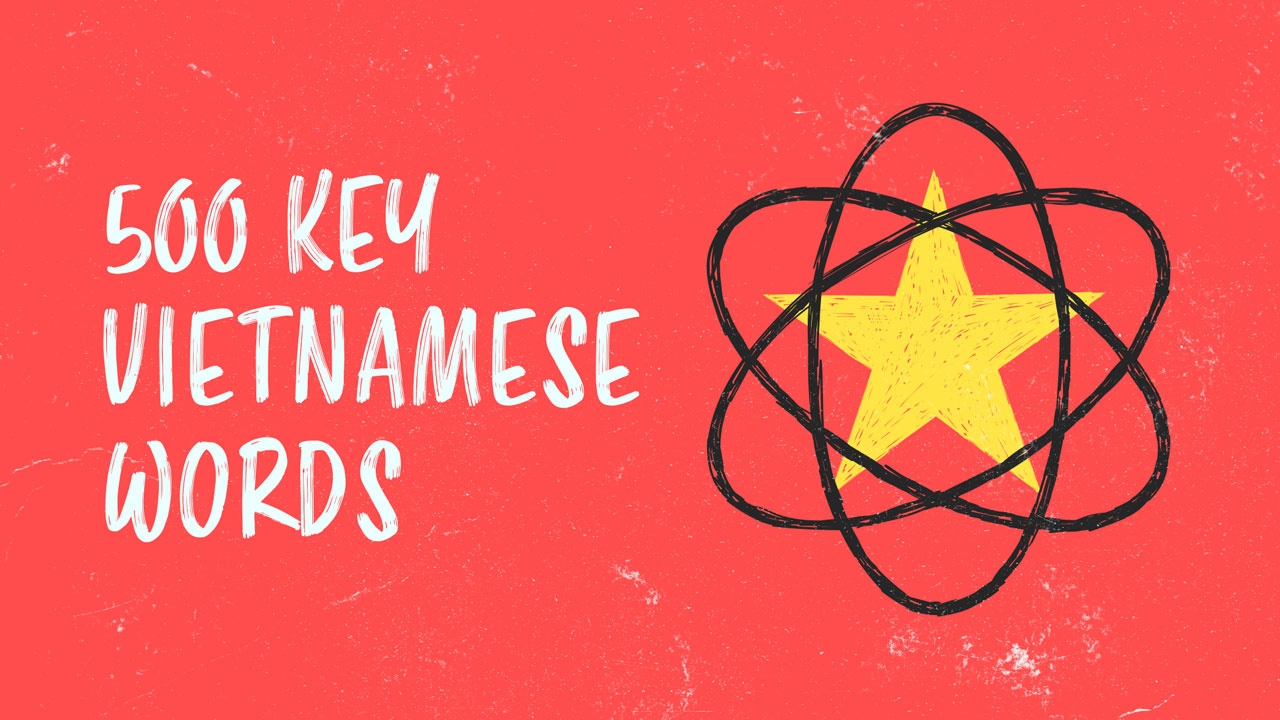500+ Key Vietnamese Words for Everyday Conversations
Read on, and you’ll learn 500+ of the most common and useful Vietnamese words. My guess is that if you master the words in this post, you’ll be able to understand the majority of Vietnamese conversations and get around just fine.
Vietnamese encompasses a rich tapestry of expressions and phrases. But just as a musician doesn’t need to know every chord in existence to play a few songs, you don’t need to master every single Vietnamese word to navigate conversations with finesse.
The Vietnamese language is known for its poetic nature and profound cultural nuances. It’s not clear exactly how many words the average Vietnamese speaker knows, but it seems to be far less than the average English speaker (15,000 to 30,000). One study estimated that Vietnamese speakers typically utilize between 4,000 and 8,000 words throughout their lifetime, and a mere 1,000 in their daily routines.
By focusing on the core words and injecting enthusiasm into your learning, you’ll discover a gateway to understanding the ebb and flow of Vietnamese conversations.
Let’s get started learning these core Vietnamese words!
Table of contents
- People and Relationships:
- Places and Locations:
- Food and Drinks:
- Traditional Vietnamese Dishes
- 20 Vietnamese Fruit Names
- 20 Popular Street Names In Vietnam
- Objects and Things In Vietnamese:
- The 10 Most Used Vietnamese Nouns Related to Nature (+ Six Bonus Words)
- The 15 Most Used Vietnamese Nouns Related to Anatomy (+ Five Bonus Words)
- The most common Vietnamese pronouns you will come across.
- Dating & Marriage Vocabulary In Vietnamese
- Here are 20 more popular nouns in Vietnamese:
- Here are the top 12 most popular male and female given names in Vietnam:
- Vietnamese Verbs
- Vietnamese Adjectives
- Most Important Numbers To Know In Vietnam
- Vietnamese Multiplicative and Fractional Numbers:
- Fractional Numbers:
- The 7 days of the week in Vietnamese:
- Category 1: Descriptive Adjectives
- Category 2: Emotional Adjectives
- Category 3: Evaluative Adjectives
- Colors In Vietnamese
- 23 commonly used Vietnamese adverbs
- 12 Vietnamese Adverbs of Place
- 11 Vietnamese Adverbs of Quantity:
- 11 Vietnamese Adverbs of Time:
- 8 Vietnamese Adverbs of Manner:
- 5 Miscellaneous Vietnamese Adverbs:
- 20 Core Vietnamese Conjunctions and Connectors
- 10 Core Vietnamese Prepositions
- 8 Vietnamese Question Words
- 8 Popular Vietnamese Interjections
- 29 Most Popular Vietnamese Classifiers
People and Relationships:
Người – “person”
Bạn – “friend”
Gia đình – “family”
Bố/ba/cha – “father”
Mẹ/má – “mother”
Anh trai – “older brother”
Em trai – “younger brother”
Chị gái – “older sister”
Em gái – “younger sister”
Người yêu – “sweetheart/lover”
Thầy – “teacher”
Bác sĩ – “doctor”
Khách – “guest”
Khách hàng – “customer”
Đồng nghiệp – “colleague”
Người lạ – “stranger” [Literally: person + strange]
Người nổi tiếng – “celebrity” [Literally: famous person]
Đối tác – “partner”
Places and Locations:
Nhà – “house, home”
Phòng – “room”
Trường học – “school”
Bệnh viện – “hospital”
Công viên – “park”
Nhà hàng – “restaurant”
Cửa hàng – “store/shop”
tiệm – “store/shop” (outdoors/not as fancy)
Chợ – “market”
Thành phố – “city”
Biển – “beach”
Sân bay – “airport”
Ga tàu – “train station”
Quốc gia – “nation”
(Đất) Nước – “country”
Nhà thờ – “church”
Chùa – “temple/pagoda”
Bưu điện – “post office”
Miền quê/nông thôn – “countryside”
kiệt/ngõ – “alleyway”
xóm/làng – “village”
Food and Drinks:
Thức/đồ ăn – “food”
Nước lọc – “drinking water”
Cà phê – “coffee”
Trà – “tea”
Bánh mì – “bread”
Bánh ngọt – “cake” [Literally “sweet bread”]
Cơm – “rice”
Thịt – “meat”
Rau – “vegetables”
Trái cây– “fruit”
Ham bơ gơ – “hamburger”
Pi za – “pizza”
Sữa – “milk”
Bia – “beer”
nươc ngọt – “sweet water” (sweet sparkling waters, soft drinks, etc)
Rượu – “alcohol”

Traditional Vietnamese Dishes
Vietnamese food continues to spread its way all across the globe. Why? Well, it’s rather delicious! Not only is it yummy, but most dishes are rather balanced and tend to be healthier than most western dishes. If you ever make it to Vietnam, you’ll be blown away by the enormous variety of traditional dishes in each region.
Here are 25 popular Vietnamese food dishes along with their English translations:
Phở bò – “Beef Noodle Soup”
Bánh mì – “Vietnamese Sandwich”
Gỏi cuốn – “Fresh Spring Rolls/ Summer Rolls”
Bún chả Hà Nội – “Grilled Pork with Vermicelli Ha Noi Style”
Bánh xèo – “Vietnamese Savory Pancake”
Cá kho tộ – “Caramelized Fish in Clay Pot”
Bún bò Huế – “Spicy Beef Noodle Soup from Huế”
Gà nướng – “Grilled Chicken”
Cơm tấm – “Broken Rice” (usually served with Grilled Pork)
Chả giò – “Fried Spring Rolls”
Bò lá lốt – “Grilled Beef Wrapped in Betel Leaf”
Mì Quảng – “Quang Style Noodles” (Popular in Da Nang and Central Vietnam)”
Canh chua – “Sweet and Sour Soup
Chả cá – “Grilled Fish with Turmeric and Dill”
Bún riêu cua – “Crab Noodle Soup”
Bánh cuốn – “Steamed Rice Rolls”
Bún thịt nướng – “Grilled Pork with Vermicelli” (This dish is common in the South and is similar to Bún chả Hà Nội)
Nem rán – “Fried Spring Rolls”
Xôi gấc – “Red Sticky Rice”
Bánh bao – “Steamed Buns”
Gỏi bò – “Beef Salad”
Bánh canh – “Thick Rice/Tapioca Noodles”
Bánh tráng trộn – “Mixed Rice Paper Salad”
Cơm gà – “Chicken Rice”
Chè – “Sweet Dessert Soup”
20 Vietnamese Fruit Names
One of my favorite things about living in Vietnam is the exotic fruit that grows in the region. Even after living here for 6 years and trying every possible fruit I could find, there are still fruits that I’ve yet to try! Here’s a list of the most popular fruits in Vietnam, most of which grow locally within the country.
Chôm chôm – “Rambutan”
Thanh long – “Dragon Fruit”
Sầu riêng – “Durian”
Măng cụt – “Mangosteen”
Mít – “Jackfruit”
Nhãn – “Longan”
Vải – “Lychee”
Mãng cầu/Na – “Custard Apple/Cherimoya”
Bưởi – “Pomelo”
Mãng cầu Xiêm/Mãng cầu Xiêm chua – “Soursop”
Vú sữa – “Star Apple”
Mận – “Plum”
Xoài – “Mango”
Dứa – “Pineapple”
Bòn bon – “Langsat”
Chanh leo/dây – “Passion Fruit”
Dừa – “Coconut”
Sa pô chê – “Sapodilla”
Dưa hấu – “Watermelon”
Đu đủ – “Papaya”

20 Popular Street Names In Vietnam
When I first arrived in Vietnam, all the street names sounded like gibberish. It took me a while to remember the names and learn how to pronounce them, but ultimately it was worth it. Like in the US, many of the common street names exist in many different cities (For example, Main Street, Washington Street, University Avenue, etc.), so I’ve included some of the most popular street names for those of you that hope to visit Vietnam some day.
Here’s a list of 20 of the most popular street names you’ll find in Vietnam.
Đường Lê Lợi
Phố Hàng Bài
Đường Trần Hưng Đạo
Phố Hàng Gai
Đường Trần Phú
Phố Nguyễn Huệ
Đường Điện Biên Phủ
Phố Lý Thường Kiệt
Đường Hàng Bồ
Phố Hàng Trống
Đường Bà Triệu
Phố Hàng Bông
Đường Hai Bà Trưng
Phố Lò Đúc
Đường Yersin
Phố Hàng Đào – “Hang Dao Street”
Đường Nguyễn Đình Chiểu – “Nguyen Dinh Chieu Street”
Phố Nguyễn Thị Minh Khai – “Nguyen Thi Minh Khai Street”
Đường Bùi Thị Xuân – “Bui Thi Xuan Street”
Phố Tràng Tiền – “Trang Tien Street”
Note: Đường and Phố both mean “Street”. Phố is used in Hầ Nội and đường is used in other cities.
Objects and Things In Vietnamese:
Bàn – “table”
Ghế – “chair”
Giường – “bed”
Tủ – “cabinet”
Điện thoại – “phone”
Máy tính – “computer”
Ti vi – “television”
Xe – “car/vehicle”
Xe điện – “electric bike”
Xe máy – “scooter/moped bike”
Xe hơi – “car”
xe buýt – “bus”
Xe đạp – “bicycle”
Sách – “book”
Bút – “pen”
Máy ảnh/hình – “camera”
Đồng hồ – “watch/clock”
Quần áo – “clothes”
Giày dép – “shoes/sandals/flip flops/slippers”
Tiền – “money”
Bàn chải – “toothbrush”
Máy giặt – “washing machine”
Đèn – “light”
đàn ghi-ta – “guitar”
khăn tắm – “shower towel”
mũ bảo hiểm – “helmet”
The 10 Most Used Vietnamese Nouns Related to Nature (+ Six Bonus Words)
Nước – “water” [Note: same word as country]
Không khí – “air”
Biển – “sea”
Ánh sáng – “light”
Mặt trời – “sun” [Literally: Face (of the) sky]
Cây – “tree”
mây – “cloud”
Hoa – “flower”
Thiên nhiên – “nature”
Lửa – “fire”
Nông thôn – “countryside”
Additional words:
Mặt Trăng – “moon” [Literally: white face]
Cánh Đồng Lúa – “rice field”
Sông – “river”
Hồ – “lake”
Núi – “mountain”
Gió – “wind”
The 15 Most Used Vietnamese Nouns Related to Anatomy (+ Five Bonus Words)
Cuộc Sống – “daily life”
Tay – “hand”
Mắt – “eye”
Phần – “part”
Giọng nói – “voice”
Chân – “foot/leg”
Đầu – “head”
mặt – “face”
nụ cười “smile”
Tâm trí – “mind”
Miệng – “mouth”
Cánh tay – “arm”
Ngực – “chest”
Tim – “heart”
Mũi – “nose”
Lưỡi – “tongue”
Tai – “ear”
Ngón tay – “finger”
Ngón chân – “toe”
Xương – “bone”
Da – “skin”
The most common Vietnamese pronouns you will come across.
Tôi – “I, Me” (formal)
Bạn – “Friend”
Mình – “Me” (informal)
Bố/Ba/Cha – “Father”
Má/Mẹ – “Mother”
Cháu/Con – “Son/Daughter”, “Grandson/GranddaughterGrandaughter”
Anh – “Older brother”
Chị – “Older sister”
Em – “Younger brother/sister”
Ông – “Grandfather”
Bà – “Grandmother”
Bác/Chú/Cậu – “Uncle”
Cô/Dì – “Aunt”
Dating & Marriage Vocabulary In Vietnamese
Vợ – “Wife”
Chồng – “Husband”
Bạn Gái – “Girlfriend”
Bạn trai – “Boyfriend”
Người yêu– “Lover”
Người thương – “Lover”
Here are 20 more popular nouns in Vietnamese:
Thế giới – “world”
Ngôn ngữ/Tiếng – “language”
Công việc – “work/job”
Trí tuệ – “intelligence/wisdom”
Kinh doanh – “business”
Trí óc – “mind/brain”
Nhân viên – “employee”
Thành công – “success”
Thất bại – “failure”
Kỹ năng – “skill”
Tham vọng – “ambition”
Tiếp thị/ma kết tín – “marketing”
Tình yêu – “love”
Hạnh phúc – “happiness”
Thể thao – “sports”
Nghệ thuật – “art”
Trang web – “website”
Khoa học – “science”
mạng – “web” (both for spiders and the internet)
mạng xã hội – “social media”
Here are the top 12 most popular male and female given names in Vietnam:
Male Given Names:
Minh
Hoàng
Hùng
Tuấn
Đức
Trung
Nam
Quang
Hải
Thành
Dũng
Cường
Female Given Names:
Hương
Linh
Thảo
Trang
Mai
Anh
Phương
Hoa
Ngọc
Lan
Thuý
Như
Vietnamese Verbs
Does Vietnamese include auxiliary verbs?
Vietnamese typically doesn’t require a “to be” verb, though in some situations it can be used. When it is used, it’s always the same word.
là – “to be”
Pretty easy, right?
For example, here are three common (and appropriate) ways I introduce myself:
Tôi tên là Jeremy – “My name is Jeremy”
Tôi tên Jeremy – “My name (is) Jeremy”
Tôi là Jeremy – “I am Jeremy”
Top 80 Most Frequently Used Vietnamese Verbs
Làm – “to work/do”
Muốn – “to want”
Nhìn – “to look/see”
Hiểu – “to understand”
Nghĩ – “to think”
Biết – “to know”
Thích – “to like”
Đến – “to come”
Gặp – “to meet”
Nói – “to say/speak”
Đứng – “to stand”
Ngồi – “to sit”
Nghe – “to listen”
Viết – “to write”
Mua – “to buy”
Bán – “to sell”
Hỏi – “to ask”
Trả lời – “to answer”
Chờ – “to wait”
Điều khiển – “to control”
Đặt – “to place an order/book”
Xem – “to watch”
Tìm – “to find/look for”
Giúp – “to help”
Dạy – “to teach”
Hát – “to sing”
Vẽ – “to draw”
Chạm – “to touch”
Chơi – “to play”
Thử – “to try”
Tập – “to practice”
Làm việc – “to work”
Học – “to study”
Dùng – “to use”
Lắng nghe – “to listen carefully”
Dừng – “to stop”
Nắm – “to hold”
Cho – “to give”
Lấy – “to take”
Chạy – “to run”
Sửa – “to fix/repair”
Nhận – “to receive”
Mở – “to open”
Đóng – “to close”
Chia sẻ – “to share”
Hỏi – “to ask”
Trả – “to pay”
Tắt – “to turn off”
Bật – “to turn on”
Gửi – “to send”
Rửa – “to wash”
Làm sạch – “to clean”
Làm việc nhóm – “to work in a team”
Làm việc tự do – “to work independently”
Sửa chữa – “to repair”
Hát – “to sing”
Nhảy – “to dance”
Nói chuyện – “to talk/chat”
Tham gia – “to participate”
Suy nghĩ – “to think”
Đọc – “to read”
Làm đẹp – “to beautify”
Gặp gỡ – “to meet”
Thoát – “to escape”
Sợ – “to be afraid”
Yêu – “to love”
Cười – “to smile/laugh”
Khóc – “to cry”
Làm đau – “to hurt”
Tin – “to believe”
Quan tâm – “to care”
Tự hào – “to be proud”
Rời đi – “to leave”
Trông chờ – “to expect/wait”
Đoán – “to guess”
Thức – “to stay awake”
Tắm – “to take a bath”
Cắt – “to cut”
Đánh răng – “to brush teeth”
Đánh – “to hit”
Vietnamese Adjectives
Most Important Numbers To Know In Vietnam
một – “one”
hai – “two”
ba – “three”
bốn – “four”
năm – “five”
sáu – “six”
bảy – “seven”
tám – “eight”
chín – “nine”
mười – “ten”
mười một – “eleven”
mười hai – “twelve”
mười ba – “thirteen”
mười bốn – “fourteen”
mười năm – “fifteen”
mười sáu – “sixteen”
mười bảy – “seventeen”
mười tám – “eighteen”
mười chín – “nineteen”
hai mươi – “twenty”
ba mươi – “thirty”
bốn mươi – “forty”
năm mươi – “fifty”
sáu mươi – “sixty”
bảy mươi – “seventy”
tám mươi – “eighty”
chín mươi – “ninety”
một trăm – “one hundred”
năm trăm – “five hundred”
nghìn – “thousand”
mười nghìn – “ten thousand”
một trăm nghìn – “one hundred thousand”
một triệu – “one million”
một tỷ – “one billion”
If you look up the word chục, some translations will say it means “dozen”, but that’s not entirely true. chục is a word used to multiply the first word by ten. You’ll often hear sellers in Vietnamese use chục instead of saying the full number. See the examples below.
hai chục – “twenty”
ba chục – “thirty”
năm chục – “fifty”
hai chục nghìn – “twenty thousand”
ba chục đô la – “thirty US dollars”
hai chục triệu – “twenty million”
Vietnamese Multiplicative and Fractional Numbers:
…Because who doesn’t love math?
Multiplicative Numbers:
gấp đôi – “double”
gấp ba – “triple”
gấp bốn – “quadruple”
gấp năm – “quintuple”
gấp mười – “tenfold”
gấp trăm lần – “a hundred times as much”
Fractional Numbers:
một nửa – “half”
một phần ba – “one third”
một phần tư – “one fourth”
một phần năm – “one fifth”
một phần sáu – “one sixth”
một phần bảy – “one seventh”
một phần tám – “one eighth”
một phần chín – “one ninth”
một phần mười – “one tenth”
một phần trăm – “one hundredth”
một phần nghìn – “one thousandth”
The 7 days of the week in Vietnamese:
Once you know the numbers, it’ll be much easier to know the days of the week. This is because most of the days include the number in it’s name! Monday is “2nd (day)”, Tuesday is “3rd (day)”, and so on.
Chủ nhật – “Sunday”
Thứ hai – “Monday”
Thứ ba – “Tuesday”
Thứ tư – “Wednesday”
Thứ năm – “Thursday”
Thứ sáu – “Friday”
Thứ bảy – “Saturday”
Category 1: Descriptive Adjectives
Đẹp – “Beautiful”
Xinh – “Pretty”
Thú vị – “Interesting”
Đáng yêu – “Adorable”
Ngon – “Delicious” (Note, Vietnamese speakers use only this word to describe good food. In English, we have many ways to state that a food tastes good, “This is yummy. This is scrumptious. This tastes so good!” In Vietnamese, ngon is the universal way to express that the food is good)
Thông minh – “Intelligent”
Hài hước – “Funny”
Mạnh mẽ – “Strong”
Quyến rũ – “Attractive”
Tuyệt vời – “Wonderful”
Hạnh phúc – “Happy”
Tự tin – “Confident”
Trung thành – “Loyal (to an organization or a leader)”
Chung thuỷ – “Loyal (in a relationship)”
Tận tụy – “Devoted”
Category 2: Emotional Adjectives
Vui – “Happy”
Buồn – “Sad”
Háo hức – “Excited”
Lo lắng – “Worried”
Sợ hãi – “Scared”
Sảng khoái – “Refreshed”
Thư thái – “Relaxed”
Hứng khởi – “Enthusiastic”
Mệt mỏi – “Tired”
Bực bội – “Frustrated”
Tự hào – “Proud”
Ngạc nhiên – “Surprised”
Bình yên – “Peaceful”
Tuyệt vọng – “Desperate”
Thỏa mãn – “Satisfied”
Category 3: Evaluative Adjectives
Tốt/hay – “Good”
Xấu – “Bad”
Tuyệt – “Excellent”
Đáng khen – “Praiseworthy”
Thành công – “Successful”
Thất bại – “Failure”
Nổi tiếng – “Famous/popular”
Trí tuệ – “Intelligent/Wise”
Kỷ luật – “Disciplined”
Đáng tin cậy – “Reliable”
Chân thành – “Sincere”
Kiên nhẫn – “Patient”
Chăm chỉ – “Hardworking”
Thông minh – “Smart”
Quan trọng – “Important”
Colors In Vietnamese
Here are 15 popular colors in Vietnamese:
Đen – “Black”
Trắng – “White”
Xanh lá – “Light green” (literally, grass green)
Xanh nước biển – “Light blue” (literally, ocean blue)
Xanh dương – “Dark Blue”
Đỏ – “Red”
Vàng – “Yellow”
Xám – “Gray”
Hồng – “Pink”
Nâu – ”Brown”
Cam – “Orange”
Tím – “Purple”
Xanh lam – “Indigo”
Vàng chanh – “Lemon yellow”
23 commonly used Vietnamese adverbs
rất – “very”
cũng – “also”
đã – “already”
chưa – “not yet”
mới – “just, recently”
luôn – “always”
đôi khi – “sometimes”
thường – “often”
hiện nay – “currently”
không – “not”
vẫn – “still”
đã từng – “once”
hẳn – “surely”
càng – “the more”
ngày càng – “increasingly”
chỉ – “only”
hầu như – “almost”
tạm thời – “temporarily”
hoàn toàn – “completely”
chắc chắn – “surely”
dần dần – “gradually”
ngay sau – “right after”
thường xuyên/hay – “regularly/often”
12 Vietnamese Adverbs of Place
ngoài – “outside”
trong – “inside”
dưới – “under” or “below”
trước – “in front”
sau – “behind” or “back”
đây – “here”, precise location
đâu – “here”, imprecise location
đằng đấy – “there”, precise location
đó – “there”, imprecise location
đi xa – “away”
xa – “far”
gần – “close”

11 Vietnamese Adverbs of Quantity:
nhiều – “more”
ít – “less”
chỉ – “only”
rất – “very much”
gần như – “almost”
hơi – “a little”
khá nhiều – “quite a lot” or “much”
đủ – “quite” or “enough”
ít nhất – “at least”
khoảng – “about” or “around”
hoàn toàn – “at all”
11 Vietnamese Adverbs of Time:
sau đó – “then”
bây giờ – “now”
luôn – “always” or “forever”
chưa bao giờ – “never” or “not yet ever”
trước – “before”
ngay lập tức – “immediately”
sau – “after”
trong khi – “during”
vẫn – “again” or “still”
sớm – “soon”, “early”, or “rapidly”
đã – “before” or “already”
8 Vietnamese Adverbs of Manner:
tốt – “well”
xấu – “bad”
mạnh – “heavily”
chậm – “slowly” or “quietly”
chỉ – “just” or “only”
cùng nhau – “together”
vui lòng – “gladly” or “willingly”
tốt hơn – “better”
5 Miscellaneous Vietnamese Adverbs:
cũng – “even”, “also”, or “too”
có lẽ – “maybe”
thay vì – “instead” or “rather”
hơn nữa – “moreover”
ngoài ra – “besides”
20 Core Vietnamese Conjunctions and Connectors
Conjunctions and connectors play a crucial role in connecting different parts of a sentence. In Vietnamese, some commonly used conjunctions and connectors include:
và – “and”
cũng – “also”, “as well”, or “even”
vậy – “so”
thế nên – “so” or “therefore”
nhưng – “but”, “yet”, or “however”
tuy nhiên – “however”
bởi vì – “because”
trong khi – “while” or “whereas”
chống lại – “against”
thay vào đó – “instead”
hoặc – “or”
cũng không – “neither” or “nor”
nghĩa là – “that is (to say)” or “namely”
thậm chí – “even”, “actually”, or “rather”
vì thế – “therefore”
như vậy – “thus”
vì vậy – “so” or “for this reason”
miễn là – “as long as”
mặc dù – “although” or “even though”
trừ khi – “unless”
10 Core Vietnamese Prepositions
Prepositions establish the relationship between two elements in a sentence. In Vietnamese, some commonly used prepositions are:
giữa – “between”
trong – “in” or “inside”
của – “of” or “from”
ở – “at”, “in”, or “on”
từ – “from” or “to”
vào – “into” or “in”
trên – “on” or “upon”
cho – “for”
cùng – “with”
không có – “without”
8 Vietnamese Question Words
When learning a new language, asking questions becomes crucial. In Vietnamese, you can navigate conversations better by knowing the following seven question words:
ai – “who”
sao/gì – “what”
ở đâu – “where”
khi nào – “when”
như thế nào – “how”
tại sao – “why”
nào – “which”
hả – “right/is it so?”

8 Popular Vietnamese Interjections
Interjections are expressive words that reflect the speaker’s emotions in a spontaneous manner. Here are seven commonly used interjections in Vietnamese:
vâng – “yes” (common mostly in Northern Vietnam)
không – “no”
ôi – “oh”
thôi – “enough” or “stop”
ơi – “hey” or “oh”
chào – “hello” or “goodbye”
đây – “here” or “this”
ủa – “really?”
ừ/dạ – “yeah/yes”
29 Most Popular Vietnamese Classifiers
If you’re like me, you may have never heard of a classifier before you began to learn Vietnamese. Unlike English, which relies on plain old numbers and generic terms, Vietnamese embraces classifiers to spice up its linguistic palette. These little words gracefully dance between numbers and nouns, expressing the unique essence and category of the objects we encounter.
Picture this: you’re holding a juicy fruit. Someone asks you, “What is in your hand?”
In English, you might say ‘one fruit’ or ‘a fruit’. But in Vietnamese, it becomes một trái where ‘một’ means ‘one’ and ‘trái’ is the classifier that whispers ‘this is a fruit we’re talking about.’ It’s like a secret handshake between the language and the noun, and a nod to its specific nature.
This is important to know, but it’s also fine if you use the wrong classifier. For example, if you ask “Can you give me a piece of milk?” in English, it’s technically not correct, but it’s still understandable.
Now, let’s unveil some of the most popular Vietnamese classifiers that add zest to everyday speech.
Cái – “general-purpose classifier”
Trái (south) /Quả (north) – “fruit”
Chiếc – “flat and flexible objects” (like sheets, leaves) and “1 in a pair/set”
Bức – “flat objects” (like paintings, photos)
Con – “animals, certain objects” (like dogs, pens)
Cành – “long, thin, and flexible objects” (like branches, wires)
Tờ – “paper made objects” (like paper, magazines)
Hạt – “small, round objects” (like grains, nuts, beads)
Đôi/Cặp – “pairs” (like shoes, socks, gloves)
Que – “long and cylindrical objects” (like sticks, toothpicks)
Cốc – “cup-like objects” (like cups, glasses)
Bình – “bottle-like objects” (like bottles, vases)
Cuốn – “rolled or cylindrical objects” (like scrolls, cigarettes)
Bộ – “sets or collections” (like books, utensils)
Tấm – “flat and solid objects” (like boards, cards)
Miếng – “flat and slice-like objects” (like pieces of cake, cloth)
Hòn – “small, round and solid objects” (like stones, pearls)
Chén – “bowl-like objects” (like bowls, cups)
Chiếc – “vehicles” (like cars, bikes)
Cốc – “cup-like objects” (like cups, glasses)
Quyển – “bound objects” (like books, notebooks)
Cành – “long, thin, and flexible objects” (like branches, wires)
Cuộn – “rolled or cylindrical objects” (like scrolls, carpets)
Đám – “gatherings or groups” (like crowds, flowers)
Hũ – “jar-like objects” (like jars, cans)
Cây – “vertical shaped objects” (like trees, poles, pens, rulers, brooms)
Đoạn – “sections or segments” (like paragraphs, roads)
Tấm – “flat and solid objects” (like boards, cards)
Alright, if you’re one of those lucky people in the world that have a photographic memory, then this post may be all you’ll ever need to be fluent in Vietnamese. But if you’re like me and you don’t have a photographic memory, hopefully this can be a resource for you to learn the essential Vietnamese vocabulary for you to have conversations, express yourself, understand native speakers, and the like.
Remember, knowing the vocabulary is one thing, you also have to speak it! So get out there and start using these words as soon as you can.



Social